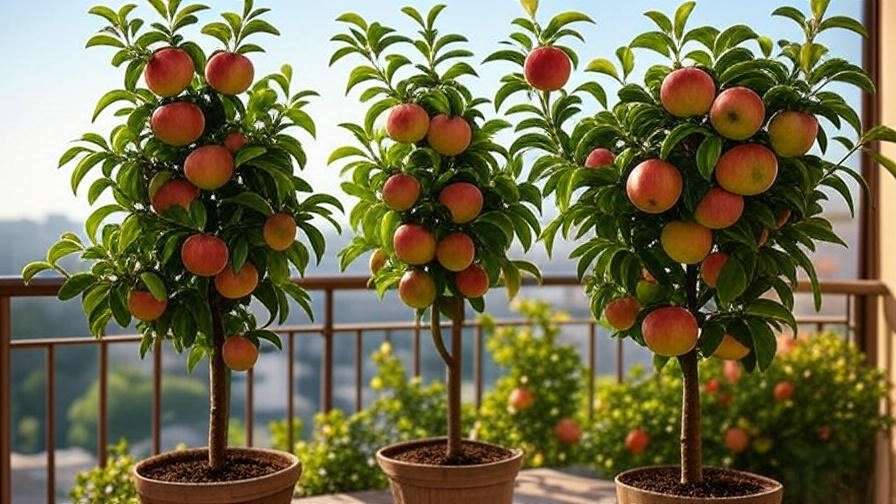Picture this: you step onto your balcony, pluck a ripe, juicy lemon from your own potted fruit tree, and savor the tangy freshness in your morning tea. No sprawling orchard, no acres of land—just a vibrant tree thriving in a pot! 🌳 Potted fruit trees are revolutionizing urban gardening, offering everyone from city dwellers to suburban homeowners the chance to grow fresh fruit in small spaces. Whether you’re dreaming of homegrown apples, figs, or citrus, this guide will walk you through everything you need to know to cultivate thriving potted fruit trees. 🍋 With expert tips, step-by-step instructions, and solutions to common challenges, you’ll be harvesting your own fruit in no time. Let’s dig in! 🧑🌾
1. Why Choose Potted Fruit Trees? 🍊
Potted fruit trees are a game-changer for anyone looking to grow their own food without a large garden. They combine practicality with the joy of gardening, making them perfect for modern lifestyles. Here’s why they’re a fantastic choice.
1.1 Benefits of Growing Fruit Trees in Pots 🌻
- Space-Saving Solution: Perfect for apartments, balconies, patios, or tiny yards, potted fruit trees fit anywhere. 🏡
- Portability: Move your tree to catch the best sunlight or shield it from harsh weather. ☀️❄️
- Year-Round Fruit: With proper care, many varieties produce fruit consistently, even in small spaces. 🍎
- Aesthetic Appeal: These trees double as stunning décor, adding lush greenery and vibrant fruit to your space. 🌸
- Eco-Friendly Gardening: Growing your own fruit reduces your carbon footprint and reliance on store-bought produce. 🌍
1.2 Who Should Grow Potted Fruit Trees? 👩🌾
Potted fruit trees are ideal for:
- Urban Gardeners: Those with limited space, like balconies or rooftops. 🏙️
- Beginners: Many dwarf varieties are low-maintenance and forgiving for new gardeners. 🌱
- Families: Kids love watching fruit grow and learning about nature. 👧👦
- Experienced Gardeners: Add a new challenge with unique varieties like dwarf avocados or olives. 🥑
Expert Insight: “Potted fruit trees democratize gardening,” says Dr. Emily Carter, a horticulturist with 20 years of experience. “They’re accessible to all skill levels and bring the joy of homegrown fruit to any space.” 🧑🔬
2. Best Fruit Trees for Pots 🍑
Choosing the right tree is critical for success. Dwarf and semi-dwarf varieties are bred for container growing, ensuring manageable size and bountiful harvests.
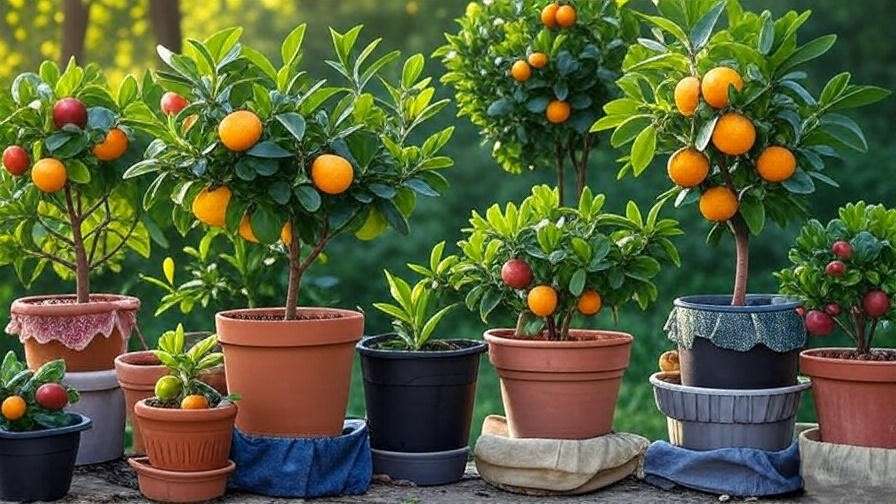
2.1 Top Varieties for Potted Growing 🍒
Here are some of the best fruit trees for pots:
- Dwarf Citrus Trees: Meyer lemons, key limes, and Calamondin oranges thrive in containers and produce year-round in warm climates. 🍋
- Fig Trees: Varieties like Brown Turkey or Black Mission are compact and prolific. 🍈
- Dwarf Apple and Pear Trees: Look for varieties like Honeycrisp or Bartlett for sweet, crisp fruit. 🍏🍐
- Stone Fruits: Dwarf peaches, plums, and cherries (e.g., Stella cherry) are excellent choices. 🍑
- Tropical Options: Pomegranates, olives, or even dwarf avocados work well in pots with proper care. 🥑
2.2 Factors to Consider When Choosing a Tree 🌳
- Climate and Hardiness Zones: Match your tree to your USDA zone (e.g., citrus for zones 9-11, apples for zones 4-8). ☁️
- Pot Size Compatibility: Ensure the pot accommodates the tree’s root system—larger trees need 15-20 gallon pots. 🪴
- Pollination Needs: Opt for self-pollinating varieties like Meyer lemons for simplicity, or plant multiple trees for cross-pollination (e.g., apples). 🐝
- Example: A Meyer lemon is self-pollinating and ideal for beginners, while a Honeycrisp apple may require a second tree, like a Gala, for fruit production. 🍋🍎
2.3 Expert Tip 💡
Choose dwarf or semi-dwarf varieties specifically bred for containers to avoid outgrowing your space. Below is a quick reference table:
| Fruit Tree | USDA Zones | Fruit Yield | Care Level |
|---|---|---|---|
| Meyer Lemon | 9-11 | High | Easy |
| Brown Turkey Fig | 7-10 | Moderate | Easy |
| Honeycrisp Apple | 4-8 | Moderate | Moderate |
| Dwarf Peach | 5-9 | Moderate | Moderate |
| Dwarf Avocado | 9-11 | Low-Moderate | Advanced |
3. Choosing the Right Pot and Soil 🪴
The foundation of a healthy potted fruit tree lies in the right pot and soil. These elements ensure proper drainage, nutrient availability, and root health.
3.1 Selecting the Perfect Pot 🏺
- Size: Start with a 15-20 gallon pot for most dwarf trees to allow root growth. Larger pots (25+ gallons) suit figs or avocados. 📏
- Material:
- Terracotta: Breathable but heavy and prone to drying out. 🪣
- Plastic: Lightweight and retains moisture but less durable. 🪴
- Fabric Pots: Promote air pruning for healthier roots but require frequent watering. 🌱
- Drainage: Ensure multiple drainage holes to prevent waterlogging and root rot. 💧
3.2 Soil Requirements for Potted Fruit Trees 🌱
- Use a well-draining potting mix, ideally a blend of peat, perlite, and compost. 🧑🌾
- Aim for a pH of 6.0-7.0 for most fruit trees (citrus prefers slightly acidic soil). ⚖️
- Add organic compost or slow-release fertilizer to maintain soil fertility. 🌿
- Expert Insight: “Soil health is the backbone of container gardening,” says Dr. Maria Lopez, a soil scientist. “Refresh 20% of the soil annually to replenish nutrients.” 🧪
3.3 Repotting Tips 🔄
- When to Repot: Every 2-3 years or when roots become crowded (visible roots circling the pot). 🌳
- How to Repot: Gently loosen roots, trim damaged ones, and transfer to a pot 2-4 inches larger in diameter. 🪴
- Signs of Root-Bound Trees: Stunted growth, yellowing leaves, or water pooling on the surface. 🕵️♀️
4. Planting and Care Basics 🌞
Proper planting and ongoing care are key to a thriving potted fruit tree. Follow these steps to set your tree up for success.
4.1 How to Plant a Potted Fruit Tree 🌱
- Choose the Right Time: Plant in spring or fall for optimal root establishment. 🌸🍂
- Prepare the Pot: Add a layer of gravel or broken pottery for drainage, then fill halfway with potting mix. 🪴
- Plant the Tree: Position the tree so the root ball sits 1-2 inches below the pot’s rim. Fill with soil and water thoroughly. 💦
- Stake if Needed: Use a bamboo stake for young trees to ensure stability. 🪵
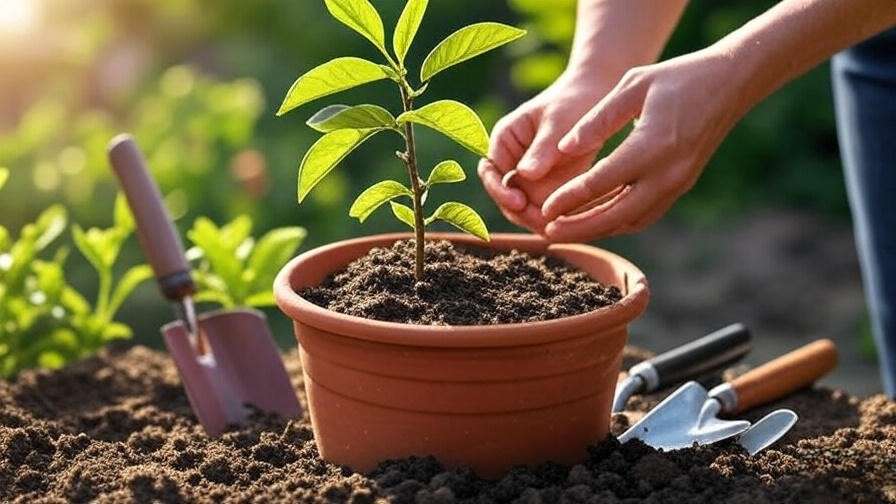
4.2 Watering Needs 💧
- Frequency: Water when the top 1-2 inches of soil feel dry—typically every 2-3 days in summer, less in winter. 🌧️
- Seasonal Adjustments: Increase watering during hot months and reduce during dormancy. ☀️❄️
- Tools: A moisture meter can help avoid over- or underwatering. 📏
4.3 Sunlight and Location ☀️
- Most fruit trees need 6-8 hours of direct sunlight daily. 🌞
- Place pots on south-facing balconies or patios for maximum light. 🌴
- In colder climates, move trees indoors near a sunny window during winter. 🏠
- Tip: Use a plant caddy to easily move heavy pots for optimal light or weather protection. 🚜
4.4 Fertilizing for Fruit Production 🌿
- Use a balanced fertilizer (e.g., 10-10-10) or citrus-specific blends for fruit trees. 🧪
- Fertilize monthly during the growing season (spring to summer) and pause in fall/winter. 📅
- Supplement with micronutrients like potassium and magnesium to boost fruit quality. 🍎
5. Pruning and Training Potted Fruit Trees ✂️
Pruning and training are essential for keeping potted fruit trees healthy, productive, and manageable in size. Proper techniques promote fruit production and prevent disease.
5.1 Why Pruning is Essential 🌳
- Boosts Fruit Yield: Pruning encourages fruiting branches and removes unproductive growth. 🍑
- Maintains Size: Keeps trees compact for container life. 📏
- Improves Air Circulation: Reduces the risk of fungal diseases by allowing better airflow. 💨
- Enhances Appearance: Shapes the tree for a tidy, attractive look. 🌸
5.2 Pruning Techniques for Beginners 🧑🌾
- When to Prune: Late winter or early spring, before new growth starts, is ideal for most fruit trees. ❄️🌸
- Tools: Use clean, sharp pruning shears or loppers to avoid damaging branches. 🔪
- How to Prune:
- Remove dead, damaged, or diseased branches. 🥀
- Trim suckers (shoots at the base) and water sprouts (vertical shoots). 🌱
- Cut back overcrowded branches to open up the canopy. 💨
- Shorten long branches to encourage fruiting spurs. 🍎
- Example: For a dwarf citrus tree, focus on removing inward-growing branches and maintaining an open, vase-like shape. 🍋 A simple diagram can help:
- [Insert placeholder for pruning diagram showing cuts for a dwarf lemon tree.]
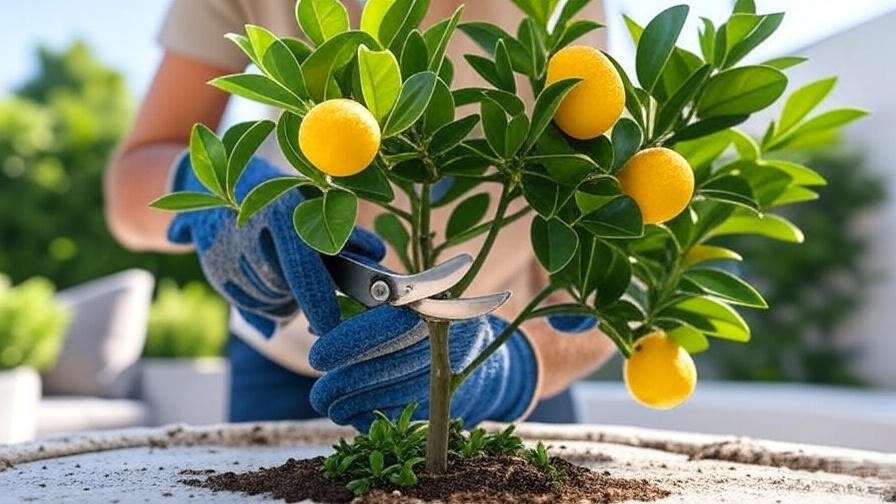
5.3 Training for Shape and Productivity 🌿
- Espalier Training: Train branches along a trellis or wall for space-saving and decorative growth. 🪴
- Columnar Training: Encourage a single, upright stem for ultra-compact varieties like columnar apples. 🍏
- Staking: Use stakes for young trees to ensure stability in windy conditions. 🪵
- Expert Tip: “Training a potted fruit tree early sets the stage for long-term productivity,” says horticulturist Dr. Emily Carter. “Start shaping in the first year for best results.” 🧑🔬
6. Common Challenges and Solutions 🐞
Even with the best care, potted fruit trees can face challenges. Here’s how to tackle common issues like pests, diseases, and environmental stress.
6.1 Pest and Disease Management 🕷️
- Common Pests:
- Aphids: Small sap-sucking insects that cause leaf curl. 🐜
- Scale: Hard, immobile pests that weaken trees. 🦗
- Spider Mites: Tiny pests causing stippled leaves. 🕸️
- Organic Control Methods:
- Spray neem oil or insecticidal soap for aphids and mites. 🌱
- Introduce beneficial insects like ladybugs for natural pest control. 🐞
- Manually remove scale with a soft brush and soapy water. 🧼
- Common Diseases:
- Root Rot: Caused by overwatering; ensure proper drainage. 💧
- Powdery Mildew: White coating on leaves; improve air circulation and apply organic fungicides. 🦠
- Expert Insight: “Early detection is key,” says plant pathologist Dr. Sarah Nguyen. “Check leaves and soil weekly to catch issues before they spread.” 🧑🔬
6.2 Environmental Stressors 🌪️
- Overwatering/Underwatering:
- Symptoms: Yellowing leaves (overwatering) or wilting (underwatering). 🍂
- Fix: Use a moisture meter and adjust watering based on season and climate. 📏
- Frost Protection: Cover trees with frost blankets or move indoors during cold snaps. ❄️
- Heat Stress: Provide afternoon shade in extreme heat and mulch the soil surface to retain moisture. ☀️
- Wind Protection: Place pots in sheltered areas or use windbreaks for outdoor trees. 🌬️
6.3 Troubleshooting Low Fruit Yield 🍎
- Causes:
- Poor pollination (e.g., lack of pollinators or incompatible varieties). 🐝
- Nutrient deficiencies (e.g., low potassium or nitrogen). 🧪
- Improper pruning or insufficient sunlight. 🌞
- Solutions:
- Hand-pollinate with a small brush for indoor or isolated trees. 🖌️
- Test soil and adjust fertilizer to address deficiencies. 🌿
- Ensure 6-8 hours of sunlight and prune to open the canopy. ✂️
7. Harvesting and Enjoying Your Fruit 🍒
The reward of growing potted fruit trees is harvesting your own delicious fruit. Here’s how to do it right.
7.1 When and How to Harvest 🥳
- Signs of Ripeness:
- Citrus: Bright color and slight give when squeezed (e.g., Meyer lemons turn golden yellow). 🍋
- Figs: Soft, slightly drooping fruit with rich color. 🍈
- Apples/Pears: Firm fruit with vibrant color; taste-test one for sweetness. 🍏🍐
- Harvesting Techniques: Use clean shears to cut fruit, leaving a short stem to avoid tree damage. ✂️
- Storage: Store fruit in a cool, dry place or refrigerate for up to a month. 🧺
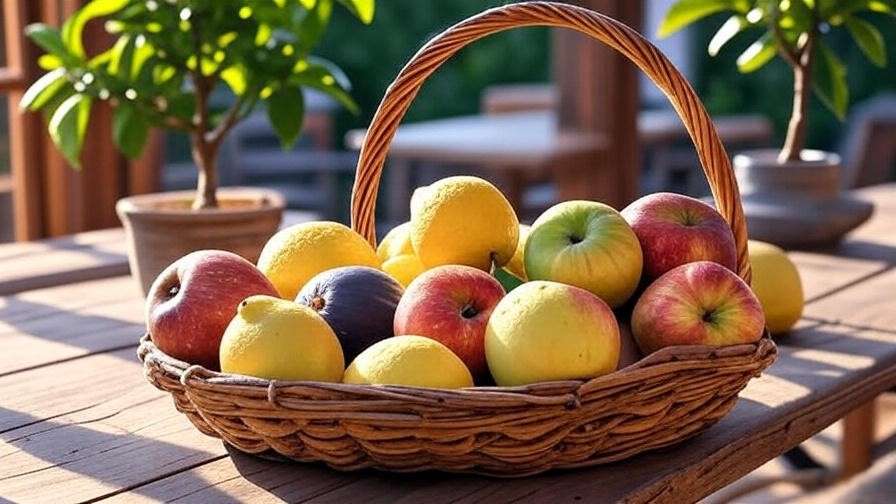
7.2 Creative Uses for Homegrown Fruit 🍰
- Recipes:
- Make lemon curd or key lime pie with fresh citrus. 🥧
- Blend figs into smoothies or bake them into tarts. 🍈
- Create apple jam or pear compote for breakfast spreads. 🍏
- Preserving:
- Freeze fruit in airtight bags for year-round use. 🥫
- Dry slices of apples or figs for healthy snacks. 🍎
- Sharing: Gift baskets of homegrown fruit to neighbors or donate to community kitchens. 🎁
8. Seasonal Care for Potted Fruit Trees 📅
Potted fruit trees require year-round attention, with care tailored to each season and your climate.
8.1 Year-Round Maintenance Tips 🌸🍂
- Spring:
- Prune to shape and remove winter damage. ✂️
- Fertilize with a balanced blend to kickstart growth. 🌿
- Repot if roots are crowded. 🪴
- Summer:
- Water frequently and monitor for pests. 💧🐞
- Provide shade during heatwaves to prevent leaf scorch. ☀️
- Fall:
- Reduce watering as growth slows. 🌧️
- Harvest ripe fruit and clean up fallen debris. 🍎
- Winter:
- Protect from frost with blankets or indoor relocation. ❄️
- Water sparingly during dormancy. 💦
8.2 Adapting to Your Climate Zone 🗺️
- Tropical Climates: Focus on citrus, figs, or avocados, which thrive in warm zones (9-11). 🌴
- Temperate Climates: Choose apples, pears, or cherries for zones 4-8. 🍏
- Arid Climates: Opt for drought-tolerant trees like pomegranates and use mulch to retain moisture. 🏜️
- Case Study: In a cold climate (zone 5), a gardener successfully grows a dwarf lemon tree by moving it indoors near a sunny window from November to March, ensuring consistent fruit production. 🏠
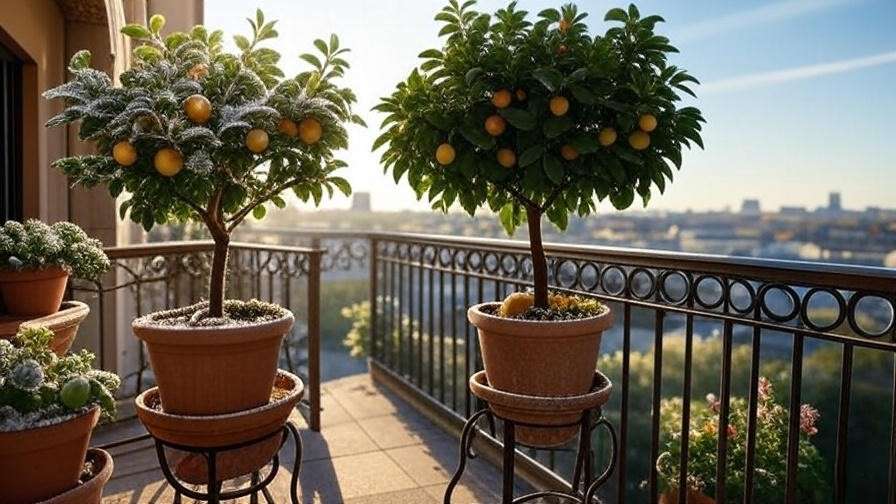
9. FAQs About Potted Fruit Trees ❓
Here are answers to common questions, backed by expert knowledge:
- How long until my potted fruit tree bears fruit? Most dwarf trees produce fruit within 1-3 years, depending on the variety (e.g., Meyer lemons in 1-2 years, apples in 2-3 years). 🍎
- Can I grow multiple fruit trees in one pot? Not recommended, as trees compete for nutrients and space. Plant one tree per pot for best results. 🪴
- What’s the best pot size for a dwarf apple tree? Start with a 15-20 gallon pot to accommodate root growth. 🍏
- How do I protect my tree from pests organically? Use neem oil, introduce ladybugs, or spray soapy water for safe pest control. 🐞
- Can potted fruit trees survive winter indoors? Yes, place near a sunny window and reduce watering to mimic dormancy. ❄️
- Source: Answers compiled from university extension services and horticultural experts. 🧑🌾
10. Conclusion: Start Your Potted Fruit Tree Journey! 🌟
Growing potted fruit trees is a rewarding way to enjoy fresh, homegrown fruit, beautify your space, and embrace sustainable living. 🍋 Whether you’re a beginner nurturing your first dwarf lemon or an experienced gardener experimenting with figs, this guide provides the tools to succeed. Start with one tree, follow these expert tips, and watch your patio transform into a mini orchard. 🌳 Share your journey in the comments or on social media with #PottedFruitTrees—we’d love to see your harvests! 📲 For more plant care tips, check out our articles on organic pest control and container gardening. 🔗 Happy growing! 🌱

